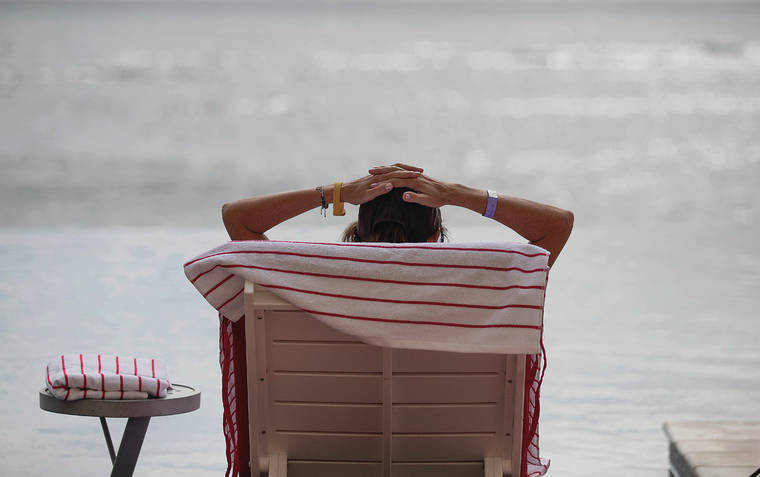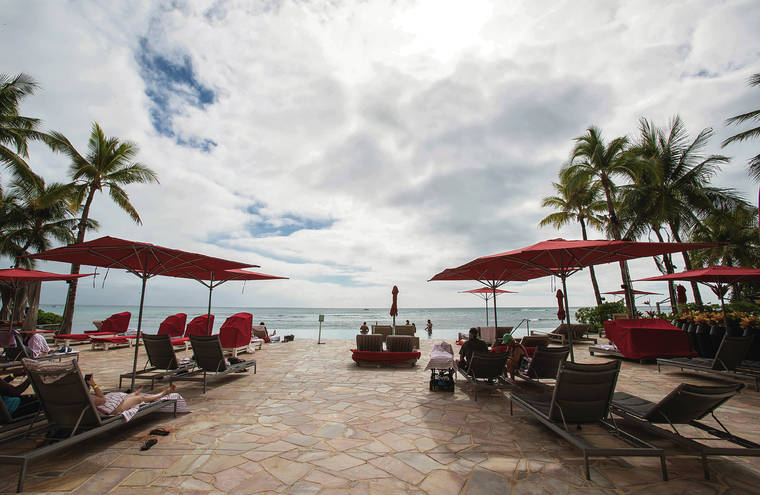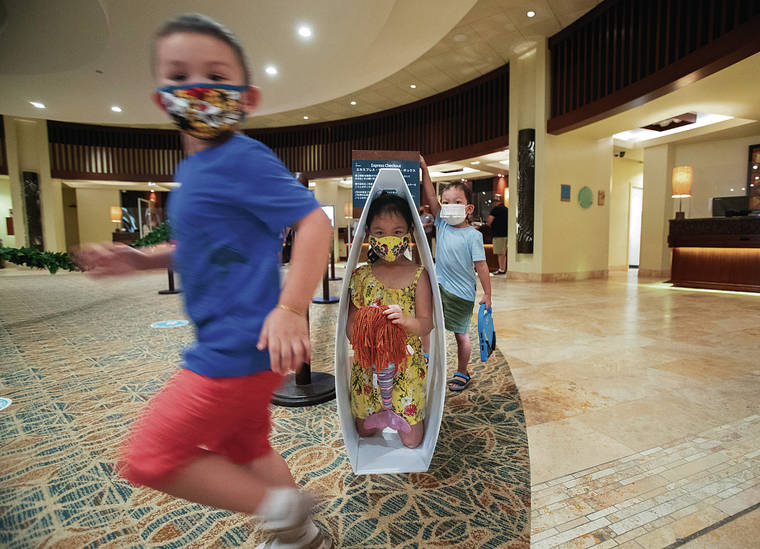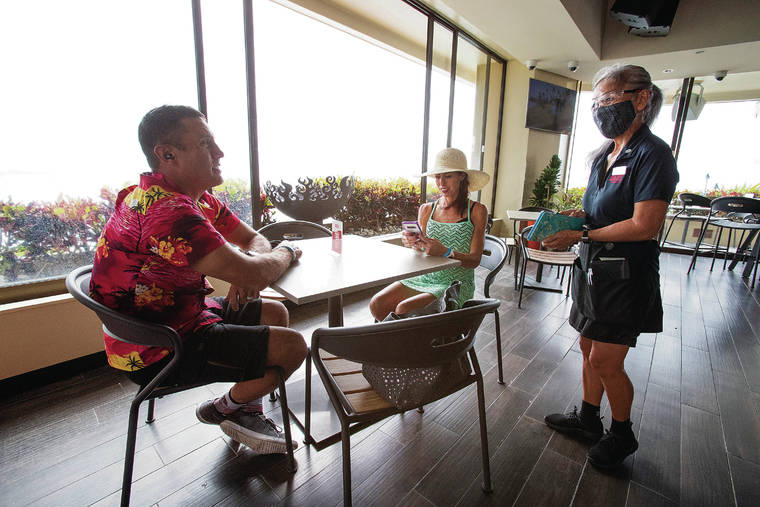Rising COVID-19 cases on the mainland, new travel advisories likely to delay Hawaii’s tourism recovery

CINDY ELLEN RUSSELL / CRUSSELL@STARADVERTISER.COM
It doesn’t appear that a large uptick in Hawaii visitors for the holiday season is going to materialize. A guest relaxed at the Sheraton Waikiki infinity edge pool on Friday.

CINDY ELLEN RUSSELL / CRUSSELL@STARADVERTISER.COM
The infinity pool is open to Sheraton guests with reservations.

CINDY ELLEN RUSSELL / CRUSSELL@STARADVERTISER.COM
While waiting for their parents to check in, 5-year-old Caitlin Chanthavong-Phungma hid in a sign as 4-year-old Tristan Inthasone ran past in the hotel lobby. Also pictured to the right is Caitlin’s 3-year-old brother, Connor.

CINDY ELLEN RUSSELL / CRUSSELL@STARADVERTISER.COM
Paul and Jocelyn Nelson placed their drink orders with Kimiko Stever on Friday at the Sheraton Waikiki’s RumFire. The couple was visiting from Portland.




The robust holiday season that Hawaii’s visitor industry anticipated is evaporating, pushing the start of a meaningful tourism recovery into the third quarter of next year.
Nobody’s got a crystal ball, but the visitor industry’s short-term future dramatically dimmed under a convergence of factors that materialized last week. Even the prospect of COVID-19 immunizations starting as soon as next month is likely to cause an immediate drop in travel demand as visitors may decide to wait until the vaccine is available, industry officials say.
Gov. David Ige’s announcement Thursday that Hawaii will tighten its entry requirements came at a time when travel demand already was expected to plummet due to a warning from the U.S. Centers for Disease Control and Prevention to avoid Thanksgiving travel.
Starting Tuesday, under the new policy, trans-Pacific passengers to Hawaii who can’t present an approved negative pre-departure test upon arrival won’t be able to bypass the 14-day quarantine, even after their test results become available.
Add to that stricter lockdowns in key western states, the top tourist market for Hawaii, and elsewhere.
Worse yet, the state’s latest visitor satisfaction and resident sentiment surveys show both groups have grown less satisfied with Hawaii tourism. Visitors say the destination isn’t back to its pre-pandemic level of activities and services, when the islands saw a record 10.4 million visitors in 2019. And some Hawaii residents are unhappy the visitor industry is trying to recover.
Don't miss out on what's happening!
Stay in touch with breaking news, as it happens, conveniently in your email inbox. It's FREE!
Statewide hotel occupancy was actually worse in October, when the pre-arrival testing program started, than in September, according to the latest hotel report from STR.
Data from Safe Travels Hawaii shows that arrivals coming for pleasure or vacation picked up steadily starting Tuesday, when 3,672 visitors were counted, through Saturday, when there were 8,322 pleasure or vacation arrivals.
But the Safe Travels website shows a steady drop-off in registered trips from 17,624 on Nov. 21 to just 4,583 on Thanksgiving Day. The registered trip count includes all future arrivals, not just visitors.
“The CDC warning will hurt travel to Hawaii for the remainder of 2020,” said Jack Richards, Pleasant Holidays president and CEO. “American people will extrapolate from the CDC announcement that they don’t want anyone traveling for 2020. We are expecting cancellations for travel to Hawaii for Thanksgiving and for the Christmas and the New Year’s holiday period.”
Richards said that even before the CDC warning, bookings to Hawaii this week were already slowing as a result of the COVID-19 surge on the U.S. mainland.
“January and February bookings to Hawaii are very low, the lowest that I’ve seen in years,” Richards said.
While bookings had started to pick up for March, Richards said the promise of a vaccine coming in short order could cause some travelers to put first- and possibly second-quarter bookings on hold.
Keith Vieira, principal of KV & Associates, Hospitality Consulting, said there’s a lot of hope around a vaccine. “It might hurt short-term bookings, but it would help long-term bookings, and that’s a trade I’d gladly make,” he said.
Vieira said Hawaii can’t control what’s happening on the mainland, but it could help support local tourism by making it easier for kamaaina travelers to visit other islands. Intrastate travelers to the three neighbor island counties currently are subject to the same testing rules as out-of-state arrivals.
Vieira said the state also could build more flexibility into its tourism entry requirements, especially given Hawaii’s low level of travel-related COVID-19 cases. Ige said Thursday that only about 44 travelers who took the pre-arrival test before departure received a positive test result upon arrival or a day or two later.
“It isn’t a large number, but it’s enough to change the policy,” the governor said. “We are adding this safety precaution now in response to the dramatically increasing number of COVID-19 cases in the continental U.S. and around the world.”
Ige said 94% of travelers participating in the pre-travel testing program for Hawaii arrive with their test in hand.
Vieira said Ige’s entry policy change will weaken travel demand for Hawaii because it makes getting here far more complicated and risky. Through no fault of their own, some travelers who followed the Safe Travels Hawaii rules have had to quarantine while awaiting overdue results from pre-departure tests.
Vieira said the state should have built in some cushion such as lengthening the test window from 72 hours to five days.
Mufi Hannemann, president and CEO of the Hawaii Lodging & Tourism Association, wants the state to allow the small portion of visitors who arrive with pending tests to test out at the new mobile testing lab at the Daniel K. Inouye International Airport, which can process up to 10,000 tests a day.
“I can appreciate the governor trying to take extra precautions. But there’s no question that it will hurt travel to the islands. I would advocate that we be as flexible as we can without compromising health and safety,” Hannemann said. “If we used the mobile testing site, they wouldn’t even have to leave the airport area.”
Hawaiian Airlines spokesman Alex Da Silva said the carrier continues to believe “there should be consideration shown for those travelers who do the right thing and, by no fault of their own, do not receive their test results in time.”
“This new restriction will create even more uncertainty for travelers and serve as a deterrent to the right kind of visitors to our state — those with the intention of testing prior to travel,” he said.
“The pre-travel testing program has allowed some amount of economic recovery and, more importantly, kept Hawaii’s infection rate as the lowest in the country and below levels experienced before the quarantine exemption launched Oct. 15. It would be a shame to undermine a program that is working by creating uncertainty for travelers.”
Las Vegas visitor Malithong Chanthavong-Phungma said she and her sister weren’t afraid to come to Hawaii with their family of 10 because the COVID-19 “numbers are much lower than in Vegas or California or Florida or Texas.”
Chanthavong-Phungma said the main driver for the timing of the family’s trip was to use airline vouchers issued after pandemic-related trip cancellations before they expire. Even so, she said the family probably wouldn’t have risked coming to Hawaii if there hadn’t been an opportunity for the state to accept late test results.
“We all got our tests in time. But I was really anxious about it. You want to make sure that you aren’t losing any money or days,” she said. “If there was a chance that we couldn’t leave the room, we would have canceled our trip again. We’d already postponed it about three times because the pre-arrival testing kept getting pushed back.”
Even without the added complication, Chanthavong-Phungma already was questioning if the Hawaii trip was worth it, given the magnitude of business closures.
The family enjoyed their time on Oahu’s North Shore, especially their trip to the newly reopened Dole Plantation. However, Chanthavong-Phungma said she’d still advise travelers to postpone vacationing in Hawaii.
“I would say wait to come unless you absolutely have to come, because you don’t have full access,” she said. “We love Hawaii, but we won’t come again until everything is back to normal and there’s no pandemic.”
—
Satisfaction slipping
Hawaii residents are largely hesitant to reopen the state to tourism. Nearly two-thirds of Hawaii residents strongly or somewhat agree that people from outside the state should not be visiting Hawaii at this time. Meanwhile, 62% disagreed that the state and county governments can safely reopen tourism and that the 14-day mandatory quarantine is being effectively enforced.
—Resident Sentiment Survey 2020
The percentage of Hawaii visitors from the U.S. West that rated Hawaii as excellent dropped from 88.4% during the second quarter of 2019 to 66.7% during the second quarter of 2020. During that same period, U.S. East satisfaction levels dropped from 91.4% to 70.1%.
— Visitor Satisfaction Study Q2 2020
Source: HTA



